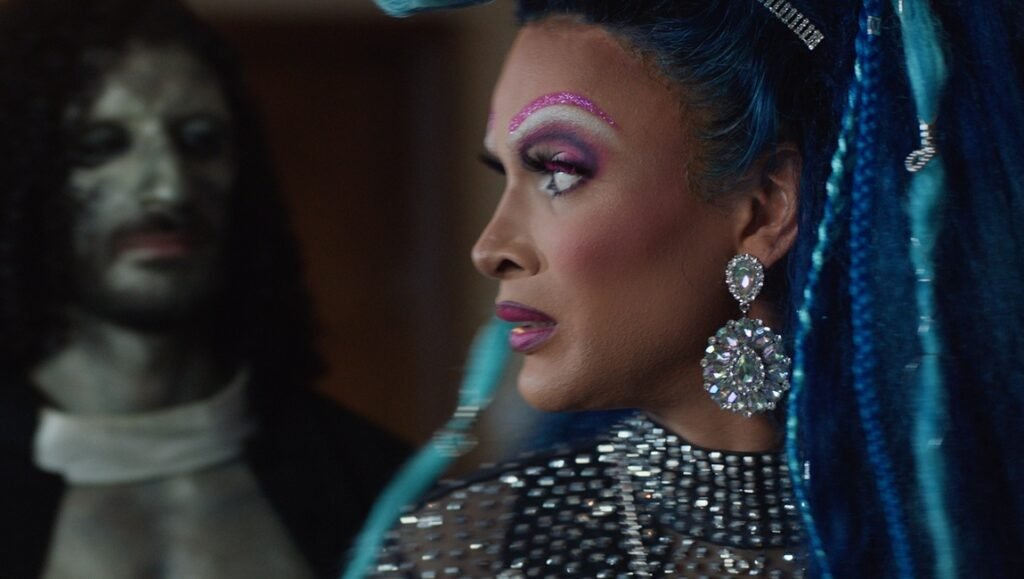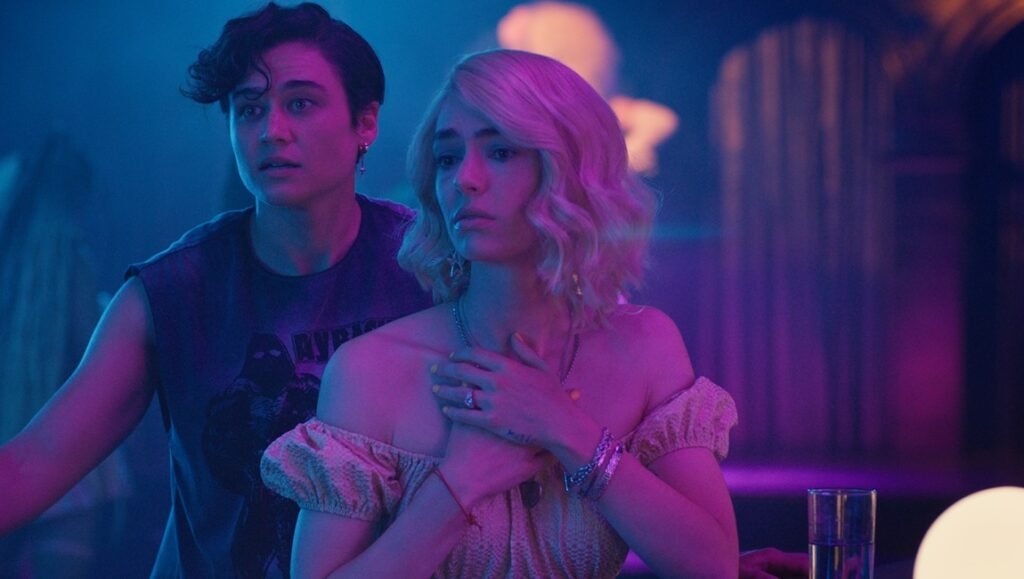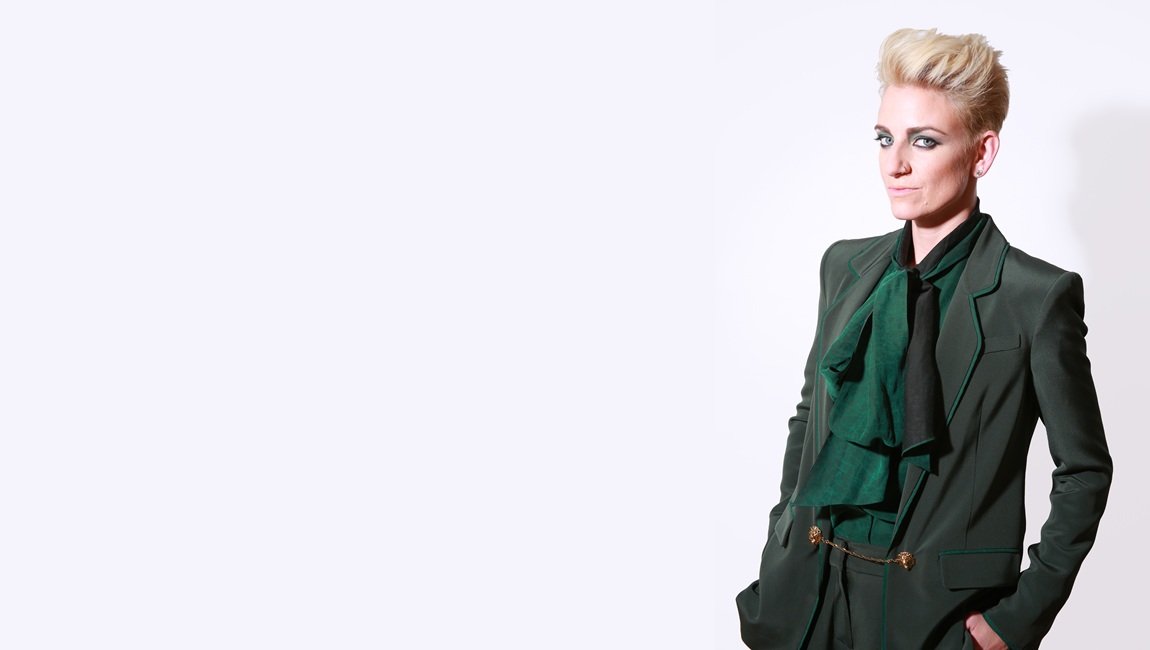Following in a famous parent’s footsteps isn’t easy. Do you embrace the legacy? Do you carve out something new entirely? What happens when that famous parent is ostensibly the guy behind an entire genre? For Tina Romero, director of Queens of the Dead and daughter of the late, great George Romero, the answer seems to fall somewhere in the middle. A clear continuation of her father’s iconic …of the Dead series, Romero’s Queens isn’t shying away from her famous lineage at all. Instead, by infusing the always societally and politically charged series with a queer sensibility, she brings the shambling, fetid zombie into the 21st century.
Set over one night in Brooklyn, Queens of the Dead follows a disparate group of friends, enemies, and acquaintances in the queer club scene as a zombie outbreak descends on the world. As is tradition, our ragtag group of misfits must abandon all ego and preconceived notions of one another if they’re going to band together and survive the night.
While housing the bones of a basic zombie movie structure, Queens of the Dead thrives because of Romero’s own sensibility. Exploding with hot pinks, neon greens, and candy purples, packed with slapstick and one-liners, and pumping with a lovely heart, her film is a delightful balm to the more self-serious zombie pictures. That isn’t to say there are no stakes — she has quite a few gut punches up her sleeve — but hers is a refreshing voice in a genre packed full of imitators. Helped by a positively stacked cast featuring Katy O’Brian, Jaquel Spivey, Jack Haven, Riki Lindhome, Nina West, Dominique Jackson, Margaret Cho, and more, Romero doesn’t just tap into the tried and true tropes of “found family.”
Inspired by a sign she saw while DJing queer clubs that said “When will the queer community stop devouring our own?”, Romero takes the backdrop of a zombie outbreak and digs into ageism in queer community, the ostracization in larger society, and how that forces folks to sometimes harden and become bitter, and the disease that is influencer culture. As funny and light as Queens of the Dead often is, its subversion of how we ingest the world around us with a focused queer lens is so insightful and biting. A gooey, bloody, and sweet addition to her father’s canon, Tina Romero’s Queens of the Dead offers a bright light forward. Whether she continues or someone else takes her lead, the …of the Dead series is in great hands.
Ahead of its release, I sat down for a fun chat with Tina Romero on Queens of the Dead, that stacked cast, our shared Pittsburgh history, and striking out on her own.
Brandon Streussnig: This cast is full of queer icons from every generation. You have Katy O’Brian and Jack Haven representing newer queers, Margaret Cho and Nina West showing up for older queers. How did you bring them all together?
Tina Romero: This cast is a miracle. It’s a dream come true. For every single one of them, it feels like the stars aligned perfectly, and I knew the cast was going to be essential to this ensemble piece. Cast was everything. I started writing letters to people years before I had any business doing so, before we had the money, before we had a green light. I was writing letters to people asking them if they would consider being in this movie. Some of those people were on my mood board from the beginning, like Katy, Nina West, and others. All I knew was that I wanted to cast this movie as authentically queer as possible. I wanted queer people in these queer roles. It was very, very important to me. Dominique Jackson was my first official “Yes.” I feel like that “yes” was a very powerful one because when you get a script that Dominique Jackson is attached to as a queer person, I think you take it a little more seriously.
Then, of course, I got the casual “yeses.” I got the yes, “we’ll attach,” and then when you get the green light, you have to sort of reconfirm that everyone’s schedule still works and that people can do it. So there was some shuffling, and Jack Haven was a last-minute add-on. The person who was asked to play Kelsey could no longer do it. We were down to the wire, and at the time, they were going by their deadname. I was a big fan, but I also knew that their gender journey was not one that was hyper-femme. I really wanted the role of Kelsey to be a hyper femme young lesbian, representing those young ones who are so comfortable in their femininity and also such proud lesbians. So we had a Zoom, and I was like, “Jack, are you cool to do this? It is a girly girl role.” And they were like, “yeah, I have an alter ego that I pull out sometimes. She’s a Russian drag queen. I’m going to channel her.” I just love that there is a whole other layer of drag in the character of Kelsey. That role was not written with drag on my mind, but I love that.
BS: Queens is obviously following a tradition that your father laid the groundwork for, one where the “Dead” represent something politically or socially. Was centering this on the queer community always the initial kernel?
TR: Totally, totally. It felt like a no-brainer mashup to me. The idea of taking drag and queer nightlife and mashing it up with zombies, I was like, that’s delicious. What a delicious, yummy way to do a zombie film, and also how special to be my dad’s kid and carry his torch and the monster forward into 2025. But to make it queer, it feels so right. Especially now in 2025, I’m so grateful that IFC and Shudder are putting this film out this year, specifically. If you make an indie film, you take it to a festival, and it can take years to get it into the world. But, with the year that we’ve had and with the shit that’s going on in the queer community, specifically in the ways that we’re feeling erased and under attack and afraid, I’m so happy that this film, the vibe of it, isn’t bleak. It’s hopeful, it’s joyful, it’s fun. I just feel really happy that this can be out in the world right now.
 Credit: IFC Films
Credit: IFC Films
BS: There’s a scene that’s stuck with me since Tribeca months ago, and it’s so small, but it’s of Katy [O’Brian] hiding away a friend who’s died, sitting on a couch for a moment, squeezing her knee in quiet anguish, and then jumping right back into the fray. It’s so representative of not only how great an actor she is, but the film’s excellent balance of wacky and dire. How did you thread that?
TR: I really love how Katy and Jaquel are so grounded. I feel like those two are rooted in the seriousness, and then they have these big, larger-than-life characters swirling around them. Katy and Jaquel, their story is the one that has the most tension. Their platonic friendship is the main drama of the film, and they are the co-leads. They share the same scene count, they’re such good actors, and they really understood my intent. They were able to maintain the seriousness of everything amidst all the chaos. I think that helps the balance of it all a lot. I also think that on the page, my co-writer Erin Judge and I started with, “okay, what is all the dark shit that we want to dig into?” I can’t be a Romero without trying to say some shit, as I’m doing a zombie film.
So that was our starting place. What’s the tapestry of social commentary that we want to make? We had our list of phones, device addiction, too much information in a crisis, tech, social media, all that junk, and then opioid and drug use in the queer community, infighting within the community, ageism from both young gays and old gays, not seeing eye to eye, not getting along. Then, the corporate poaching of queer talent. So once we had all that stuff and we were able to put that on the page, I think that it left room for the characters to come in and play a little bit. Together with the cast, we were able to find the balance of “okay, now it’s time to hit our marks and say the lines and get the script done” vs “now it’s time to play and have fun and improvise.”
It was really just a dance with the cast and the script and figuring out where those moments were where we could breathe and be light and playful and where we needed to focus and get it done. They just did such a good job, and they understood what we needed to do. I’ve been saying it a lot: it was all queens, no divas. This was a family-style shoot. We didn’t have private trailers, we didn’t have dressing rooms, we ate meals together. We were all on a first-name basis, the crew and the cast. I also think that having an incredibly gay and queer crew made on on-set experience very, very queer. That made everybody feel safe and welcome and able to just be themselves. I think that comes through in the ways that these people brought themselves to their characters.
BS: I live in New York now, but like you, I’m from Pittsburgh and spent most of my life there. I loved the little nods, like the Iron City Beer sign, to our city throughout the film.
TR: Oh my god! Did you see the Steelers jacket?
BS:I did, yeah!
TR: That was me! That was my cameo!
BS: Oh wow! Amazing. Was there ever an iteration of the script that set the film in Pittsburgh, like some of the previous entries?
TR: I did think about it, yeah. Do you know the town of Monessen?
BS:I do, yeah. I played football against them in high school.
TR: Okay, so you know it’s a little bit of a depressing town, but it’s also the home of Tom Savini’s School of Makeup. I’ve visited there, I’ve done some guest teaching there, and for one second, I was like, “this would be an interesting location for this film.” However, at the end of the day, I needed to tell a story that I could tell in a world that I knew, and the world that I know is Brooklyn nightlife.
There’s something so unique and special about queer nightlife in New York City. I wanted them to be stuck in Brooklyn, because what a mess! To be in Brooklyn or Manhattan in the event of a zombie apocalypse, what a nightmare. I knew I wasn’t going to have the budget to do a World War Z version of this, where the Brooklyn Bridge is covered in zombies. I knew that wasn’t going to happen. But the problem of being in an urban environment with the zombies rising creates a very immediate problem: do you stay, or do you go? I just love the idea of them having to get to Queens to get to a boat in Queens of the Dead. It felt more right to me to tell a story in a place where I consider home now. Even though I did consider the possibility of setting it in Pittsburgh, I quickly pivoted, and I was like, “No, I need to tell a story that I can tell.”
 Credit: Fantasia Festival/IFC Films
Credit: Fantasia Festival/IFC Films
BS: This is so clearly your own vision. It’s so colorful and funny and leans into the camp a bit, but it’s also extending the path your father laid. What was the approach to taking what you might have learned from him or from Savini while still keeping a vision that’s truly your own?
TR: Oh, thank you. That means a lot to hear. Thank you. Well, the first part of that, I think one of the biggest lessons I learned from my dad observing him on set was he was the kind of guy who, if a wardrobe department came to him and said, “George, we have two options. Do you like this one or this one?” He would say, “What do you think?” He was really unafraid to collaborate with the genius minds around him. He treated everybody like family. He said, “please,” and “thank you.” He was a nice guy. And as simple as that is, I don’t know, I think that means a lot when you’re on a film set and collaborating to work with incredible talent. Making a film is so cool. You have all of these incredible minds coming together to solve a problem. He was just an amazing collaborator. He was also playful, and Tom Savini is, too. They’re both big kids.
On the most stressful days on set, when we were running out of time and shit was falling apart was during the scooter scene, where we had Nina West, Tómas, and Jaquel on scooters and a fog machine and a big light, and 60 zombies — it was so incredible. But I had three minutes to shoot it, and I was so stressed out and pissed that I only had three minutes. And I would hear my dad telling me to chill out and flip the perspective and say, “Tina, look how amazing this is. Look how lucky you are that you get to do this. You’re making a zombie movie at 4:00 AM in the streets of New Jersey. Have fun. Don’t forget to play.” At the end of the day, I think what’s so special about my dad’s zombies is that they’re slow, they’re sympathetic, and they’re silly.
Those are the things I really wanted to take over from him, to make sure that the spirit of these zombies was all of those things. And then, I mean, I am a homosexual, and I have a penchant for pink, and I like production design, and I like colorful things. So then I just wanted to stay true to my own aesthetics and my own sensibilities when it came to the look of it and the feel of it. I didn’t want this film to feel bleak and hopeless. I wanted it to be victorious and hopeful and fun. So I think it was like, yeah, I tried to channel my dad, but also stay true to myself.
BS: Where do you see the Dead heading next?
TR: Oh my god, that’s a great question. I’ve been thinking a lot about where are they going on this boat? Are they going to Fire Island, maybe they’re going to Iceland? That would be cool, too. But I guess I want to see them keep fighting. We left a lot of survivors, and I think it’s begging. I would like to do a sequel. I would like to see what happens to his characters. I’m very curious about what happens to Nico specifically. What about the rest of the queer community? What are the gays doing to deal with the zombies in the future? How are they hanging on to their undead in the ways that we’ve seen my dad do that in Survival [of the Dead]? How are they keeping the undead around? So that’s kind of what I’m chewing on right now.

